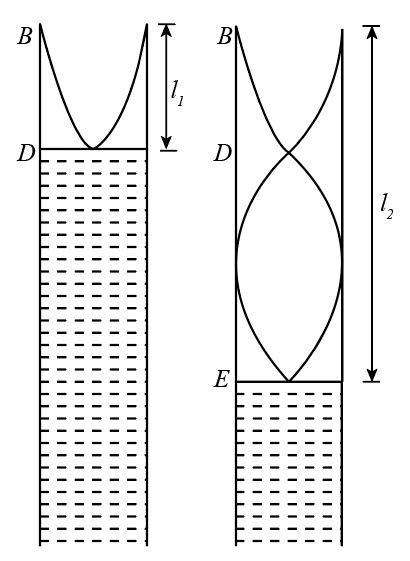
What is resonance? By drawing the diagram of a resonance tube, calculate the formula for velocity of sound in air.
Answer
568.2k+ views
Hint: From the concept of resonance, we know that when an object is vibrating at a higher frequency than that of a specific value, then that frequency of vibration can be termed as the frequency of resonance, and this process is called resonance.
Complete step by step answer:Let us draw the diagram of the resonance tube, which is filled with water to a certain level as shown below:

Here \[{l_1}\] is the column of air's length for the first case of resonance and \[{l_2}\] is the air column length in the second resonance case.
With the help of a tuning fork of higher frequency, we can experiment for resonance.
From the above diagram, we can see that the sound wavelength is equal to twice the difference of the lengths.
\[\lambda = 2\left( {{l_2} - {l_1}} \right)\]
Here \[\lambda \] is the wavelength of the sound.
We know that the expression for the velocity of sound in air is equal to the product of its frequency and wavelength so that we can write:
\[V = f\lambda \]
Here f is the frequency of the sound produced.
We will substitute \[2\left( {{l_2} - {l_1}} \right)\] for \[\lambda \] in the above expression to get the formula for the velocity of sound in air.
\[\begin{array}{c}
V = f2\left( {{l_2} - {l_1}} \right)\\
\Rightarrow 2f\left( {{l_2} - {l_1}} \right)
\end{array}\]
Therefore, we can say that the velocity of sound in air is given by \[V = 2f\left( {{l_2} - {l_1}} \right)\].
Note:The velocity of sound depends on the temperature of operation, which means if the temperature of air varies, then the velocity of sound also varies. We have performed the above expression at room temperature. We have to ensure that the tube is vertical and still so that other hindrances can be ruled out.
Complete step by step answer:Let us draw the diagram of the resonance tube, which is filled with water to a certain level as shown below:

Here \[{l_1}\] is the column of air's length for the first case of resonance and \[{l_2}\] is the air column length in the second resonance case.
With the help of a tuning fork of higher frequency, we can experiment for resonance.
From the above diagram, we can see that the sound wavelength is equal to twice the difference of the lengths.
\[\lambda = 2\left( {{l_2} - {l_1}} \right)\]
Here \[\lambda \] is the wavelength of the sound.
We know that the expression for the velocity of sound in air is equal to the product of its frequency and wavelength so that we can write:
\[V = f\lambda \]
Here f is the frequency of the sound produced.
We will substitute \[2\left( {{l_2} - {l_1}} \right)\] for \[\lambda \] in the above expression to get the formula for the velocity of sound in air.
\[\begin{array}{c}
V = f2\left( {{l_2} - {l_1}} \right)\\
\Rightarrow 2f\left( {{l_2} - {l_1}} \right)
\end{array}\]
Therefore, we can say that the velocity of sound in air is given by \[V = 2f\left( {{l_2} - {l_1}} \right)\].
Note:The velocity of sound depends on the temperature of operation, which means if the temperature of air varies, then the velocity of sound also varies. We have performed the above expression at room temperature. We have to ensure that the tube is vertical and still so that other hindrances can be ruled out.
Recently Updated Pages
Why are manures considered better than fertilizers class 11 biology CBSE

Find the coordinates of the midpoint of the line segment class 11 maths CBSE

Distinguish between static friction limiting friction class 11 physics CBSE

The Chairman of the constituent Assembly was A Jawaharlal class 11 social science CBSE

The first National Commission on Labour NCL submitted class 11 social science CBSE

Number of all subshell of n + l 7 is A 4 B 5 C 6 D class 11 chemistry CBSE

Trending doubts
10 examples of friction in our daily life

One Metric ton is equal to kg A 10000 B 1000 C 100 class 11 physics CBSE

Difference Between Prokaryotic Cells and Eukaryotic Cells

1 Quintal is equal to a 110 kg b 10 kg c 100kg d 1000 class 11 physics CBSE

State the laws of reflection of light

Explain zero factorial class 11 maths CBSE




